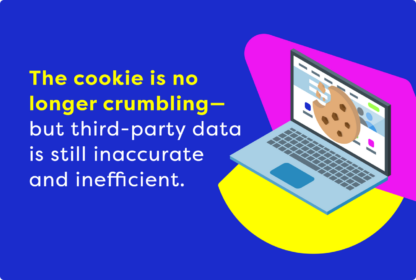It’s been over a month since Google announced that third-party cookies are here to stay. Sort of.
In its about-face, Google will now introduce a new prompt in Chrome for Internet users to choose how they want advertisers to track them across the web giant’s search products. In this way, Google hopes to allow consumers to make informed choices that apply across their web browsing and to change that choice at any point. It’s much like Apple did in 2021 when it let iPhone users begin opting out of being tracked across other phone apps.
When you think about it, consumer privacy and choice brought us to this point.
But, as a marketer, you can’t sit still and wait for Google’s next move. The answers and solutions for brands like yours that want to eliminate third-party cookies have existed for some time.
Long before cookie deprecation was even a glimmer in Google’s eyes, there were other ways to identify decision-ready consumers and engage them across digital and offline properties. PebblePost innovated on many of those to provide marketers with addressable and performance-driven solutions in this new era of marketing.
That house in the middle of the street
There’s an identifier that’s been around even longer than the third-party cookie: the household address.
This is the identifier retailers used to send out mail-order catalogs, which date back to 1872 when Montgomery Ward produced its first catalog. By 1904, 3,000,000 customers were on their catalog mailing list. Since direct mail is still a thriving channel, the household address remains a mainstay in marketers’ toolkits. Unlike digital identifiers, an offline identifier like the household address is far more persistent and unable to be made obsolete by a software update. If someone moves, they must update their address to receive mail and other services. You can’t just opt out of your address like you can cookies.
What’s more, using the household address as an identifier enables offline and online customer connections that third-party cookies never could.
Even though we are very much in the digital age, the household address is paving the way for hybrid channels like connected TV, digital out-of-home, and Programmatic Direct Mail, which blend the offline and the online to target and engage consumers more precisely. Accurate postal addresses allow marketers to match online activities with offline purchases (in-store and over the phone, for instance) with near-deterministic certainty, enabling a holistic view of customer behavior. This data is vital to optimizing and scaling marketing campaigns and generating insights into what drives performance beyond online intent signals.
Thanks to the household address as an identifier, marketers can use more robust customer and behavior intel to execute personalized, efficient, and precise targeting while respecting customer privacy across all touchpoints.
Sharing—data that is—is caring
As the decades wore on, the mail-order catalog retailers began paving the way for how marketers can use data in their campaigns today.
How? By sharing their first-party data.
A little more than three decades ago, these catalog retailers pooled their first-party data about their customers and their transaction histories into a cooperative database to improve their prospecting.
As we know, no one shops at just one brand and first-party data doesn’t scale. So, this data-sharing arrangement was mutually beneficial while still being privacy-forward (long before the Internet began) because all of this contributed first-party data was aggregated (and, therefore, anonymized) information.
In this way, retailers felt comfortable participating and received information on the customers that other companies provided as a reward. Because this data included past purchases, it offered an idea of what a customer might buy next. This same concept applies today online, with some improvements.
Today, technology has improved how brands can pinpoint to whom to send which offers, increasing the probability that their target audiences will convert.
Retailers and other businesses can now maximize their own first-party data with a privacy-protected identity graph, enhancing the performance of their prospecting and retention programs. That’s what the PebblePost Graph is all about. It includes billions of fresh and accurate online household, intent, and transaction data points from hundreds of brands. Tapping into this shared first-party data asset helps you reach consumers who are decision-ready to make their next purchase at that moment.
And, if you haven’t already come to this conclusion, no cookies are required to participate in and benefit from this shared first-party data graph. It’s all upside.
Everything old is new again
As this blog post shows, the good news is there’s still plenty of signal beyond third-party cookies.
The only thing truly diminishing is marketers’ reliance on outdated technology to identify and engage consumers across the Internet—as it should.
We know what we’re talking about. The PebblePost Graph connects billions of first-party household, online intent, and transaction data points we refresh daily. This nets out to about 10,000 online intent signals per mail piece, increasing the likelihood of reaching a decision-ready consumer with your postcard offer. At the core of our graph are households, providing a solid foundation of offline identifiers so you can build your strategy without having to fret over what happens with cookies or any other online identifier to come.
Unlike other alternatives to the third-party cookie, The PebblePost Graph doesn’t require laborious technology or system overhauls that require testing and more testing to see if they work. Using durable identity and high-quality shared first-party data, we make it easy to start participating and seeing the results of cookieless, addressable marketing that drives results at scale. And we do it all in a privacy-by-design framework.
If you’re interested in learning more, we are here to help.



